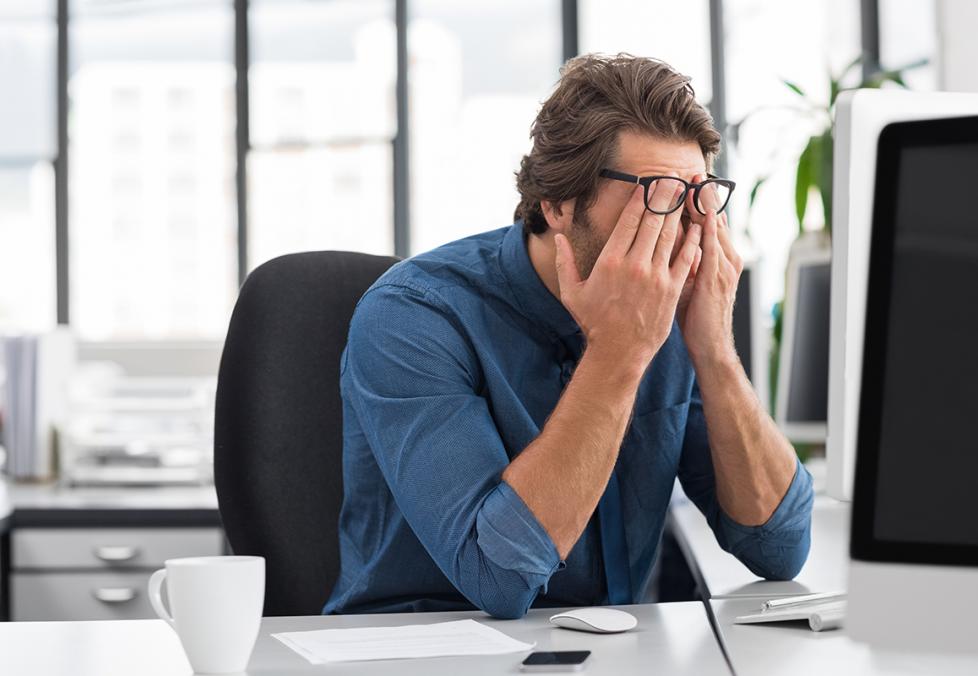
Living in the digital age can seriously tax your eyes. But it’s not the only reason for eyestrain. Here’s what you need to know.

Your legs ache after a run. Your brain grows weary after focusing for hours. Your eyes, just like any other body part, get tired after demanding activities. That could be filling out paperwork, taking a long drive, or bingeing your favorite television show.
It’s probably not surprising to learn that digital devices are among the most common reasons for eye fatigue. Officially called computer vision syndrome, digital eyestrain has skyrocketed since the start of the COVID-19 pandemic. This condition now affects a whopping 78% of adults.
Children and teens are also at risk of eyestrain, especially if they spend a lot of time looking at screens. And most kids do — whether they’re writing essays on their school laptops, playing video games, or using their cell phones.
“Humans were not meant to be on a digital device for several hours a day, but that is the world we live in now,” says Valerie Ferrell, O.D., an optometrist at America’s Best Contacts & Eyeglasses in Easley, South Carolina. “We’re constantly staring at phones, tablets, computers, or TVs.”
Although screens are a major driver of eyestrain, they’re not the only cause. Plenty of other activities can wear out your eyes and lead to pesky symptoms such as dryness and sensitivity. Learn more about what can trigger eyestrain, plus how you can prevent, manage, and treat it.
Have questions about your eye health or vision? Your America’s Best optometrist is here to help. Click here to find an exam time that fits your schedule.
What is eyestrain?
Eyestrain (also known as asthenopia) is a general term that can refer to a number of different issues related to eye fatigue. “Eyestrain is not an actual medical condition,” says Dr. Ferrell. “It’s one or more symptoms that occur after using your eyes for an extended period.”
What causes eyestrain?
Eyestrain usually comes down to underlying lifestyle factors that are stressing out your eyes, whether it’s a one-off situation or part of an everyday routine. Here are some of the more common causes:
- Your prescription is outdated. If the prescription in your eyeglasses or contact lenses is wrong — or you need corrective lenses but don’t wear them — it can lead to eyestrain. Your eyes are working extra hard to compensate for poor vision.
- You’ve been focusing hard. Sometimes, the muscles in and around the eyes may feel fatigued after focusing for a long time. This is especially true when you’re focusing on fine details (on a screen or off), such as reading fine print, sewing, or making spreadsheets.
- Your desk setup needs adjusting. Eyestrain can also be related to poor ergonomics, such as a misaligned desk and office chair causing achiness and fatigue.
- You’re not blinking enough. A lack of lubrication, aka dry eye syndrome, is another cause of eyestrain. “When we’re concentrating on a demanding task, we tend to blink less,” says Dr. Ferrell. We also blink less often while looking at screens. “As a result, the surface of the eye dries out,” she says.
- Poor lighting. Light — either too bright or too dim — can cause a type of eyestrain known as photophobia. “People often complain about eyestrain due to bright fluorescent lights, sunlight, or lights from cars while driving at night,” says Dr. Ferrell.

What are the symptoms of eyestrain?
Symptoms of eyestrain run the gamut: Soreness, fatigue, itching, and burning are common, as are dry or watery eyes.
Sensitivity to light and blurred or double vision can indicate overuse of the eyes, which is likely causing strain. A headache or sore neck, shoulders, or back can also point to eyestrain.
Even having trouble concentrating or keeping your eyes open can signal eyestrain. That’s why it’s important to pay attention to the circumstances of your symptoms, so that you can pinpoint and address the issue.
Who is at risk of eyestrain?
“Eyestrain tends to happen in individuals who are school age and up, as most people who are students or work indoors are using digital devices or reading small print all day,” says Dr. Ferrell.
School-age kids are also the group most likely to spend hours playing video games. (Digital eyestrain is likeliest to affect those who spend more than two consecutive hours a day looking at screens.) If you notice your child rubbing their eyes more than usual or complaining of blurred vision or headaches, it could signal digital eyestrain.
People with untreated eye issues, such as uncorrected vision or a muscle imbalance (amblyopia or strabismus) also have a heightened risk of eyestrain.
How is eyestrain diagnosed?
If your symptoms don’t improve after you give your eyes a break, visit your optometrist for an eye exam. They can help rule out a more serious condition.
“If a patient complains about a pulling sensation in their eyes after reading a tablet, I will check to make sure the eye muscles are functioning properly,” says Dr. Ferrell. “I would also check for a refractive error, which may indicate a need for prescription glasses. And if a patient tells me their eyes feel gritty after watching TV for hours, I’ll perform dry eye tests.”
How is eyestrain treated?
Because eyestrain is often related to work and lifestyle habits, making a few tweaks can help prevent and treat eyestrain symptoms.
If you think your vision has changed, ask your optometrist about corrective lenses. This is a good idea even if you just think you need basic reading glasses. “Don’t sell yourself short by buying over-the-counter glasses,” says Dr. Ferrell, because they aren’t formulated specifically for your eyes.
If you’re dealing with digital eyestrain from working at a computer, it’s not really feasible to give up screens entirely. Luckily, there are a number of tips that may help relieve digital eyestrain, including:
- The 20-20-20 rule. Take a 20-second break to look at something 20 feet away every 20 minutes.
- The 1-2-10 rule. Keep phones one foot away from your eyes, laptop screens two feet away, and TV screens 10 feet away.
- Adjust your screen settings. Change the text size, brightness, and contrast levels until you find what feels best for your eyes.
- Force yourself to blink. Blinking is usually automatic, but we do it less often while we’re looking at screens. Making a conscious effort to blink will help keep your eyes moist.
Got a long commute? Protect your eyes while driving by keeping glasses free of smudges or dirt (which can scatter light) and by directing air vents away from your eyes.
Your eyewear can also go a long way toward preventing eyestrain. Be vigilant about wearing sunglasses for protection whenever you go outdoors. If you’re sensitive to light while indoors, Dr. Ferrell suggests trying glasses with an anti-glare coating. Blue light–blocking glasses may also be helpful to wear if you frequently need to be on your computer or use screens at night, as blue light can interfere with sleep.
Are dry eyes the problem? Be mindful of blinking periodically, and supplement with artificial tears. “I like to keep lubricant drops in the refrigerator,” says Dr. Ferrell. “Whenever my eyes are tired or dry, I apply a cool drop and close my eyes for a few minutes for relief. Warm compresses with an eye mask for 10 to 15 minutes can help rejuvenate tired eyes, as well.”
Can eyestrain permanently harm eyes?
You’ll be relieved to hear that eyestrain isn’t serious, and it can never permanently harm the eyes. But that doesn’t mean you should shrug it off. Eyestrain can lead to headaches and eye discomfort, and nobody wants to deal with that.
“If eyestrain is a common occurrence in your life, do not ignore it or suffer through it,” says Dr. Ferrell. “There are several smart solutions to combat eyestrain. Visit your eye care provider to determine which solution is right for you.”
Medically reviewed by Valerie Ferrell, O.D.
See our sources:
Computer vision syndrome overview: Cleveland Clinic
Digital eyestrain and blue light glasses: National Center for Health Research
How ergonomics contribute to eyestrain: UCLA Ergonomics
Eyestrain overview: Mayo Clinic
How screen time affects kids’ eyes: Children’s Hospital of Philadelphia
Preventing eye fatigue on long road trips: Baylor College of Medicine

